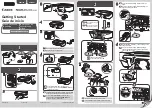
TS1700/TK18 PRINTERS OPERATION MANUAL
GS
h
n
[Name]
Select bar code height
[Format]
ASCII
GS
h
n
Hex
1D
68
n
Decimal
29
104
n
[Range]
<01>H
≤
n
≤
<FF>H
[Description]
Selects the height of the bar code.
n
specifies the number of dots in the vertical direction (
n
x 0.125mm).
[Default]
n
= <A2>H (162 dots
20,25mm)
[Reference]
GS k
GS k
m n d1...dn
[Name]
Print bar code
[Format]
ASCII GS
k
m
n
d
1...
dn
Hex
1D
6B
m
n
d
1...
dn
Decimal
29
107 m
n
d1...dn
[Range]
m
= <43>H,
m
= <45>H,
m
= <46>H or
m
= <49>H
(
n
and
d
depend on the bar code system used).
[Description]
Selects a bar code system and prints the bar code.
m
selects a bar code system as follows:
m
Bar Code
System
Num. of characters
Remarks
<43>H EAN13
n
= 12
48
≤
d
≤
57
<45>H CODE39
1
≤
n
≤
255
48
≤
d
≤
57, 65
≤
d
≤
90, 32, 36,
37, 43, 45, 46, 47
<46>H ITF
1
≤
n
≤
255 (even)
48
≤
d
≤
57
<49>H CODE128
2
≤
n
≤
255
0
≤
d
≤
127
[Notes]
●
n
indicates the number of bar code data bytes, and the printer processes
n
bytes
from the next character data as bar code data.
● If
n
is outside the specified range, the printer stops command processing and
processes the following data as normal data.
● If
d
is outside the specified range, the printer only feeds paper and processes the
following data as normal data.
●
If the horizontal size exceeds printing area, the printer only feeds the paper.
●
This command feeds as much paper as is required to print the bar code, regardless
of the line spacing specified by
ESC 2
or
ESC 3
.
●
This command is enabled only when no data exists in the print buffer. When data
exists in the print buffer, the printer processes the data following
m
as normal data.
●
After printing the bar code, this command sets the print position to the beginning of
the line.
●
This command is not affected by print modes.
●
The number of data for the ITF bar code must be even numbers. When an odd
number of bytes of data is input, the printer ignores the last received data.
●
When Code128 (
m
=49h) is used:
1. When using Code128 in this printer, take the following points into account
for data transmission:
The top of the bar code data string must be the code set selection
character (CODE A, CODE B or CODE C), which selects the first
code set.
Special characters are defined by combining two characters “
{
“ and
one character. The ASCII character “
{
“ is defined by transmitting “
{
“
twice consecutively.
48/62















































